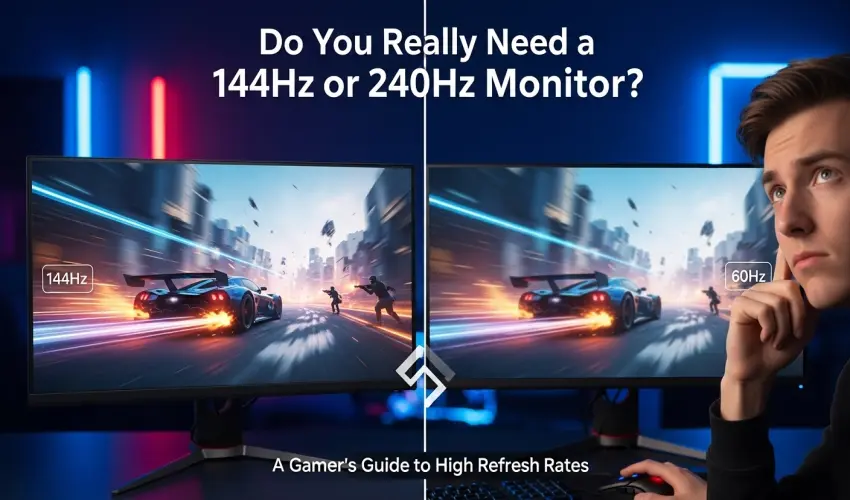Do You Really Need a 144Hz or 240Hz Monitor? A Gamer’s Guide to High Refresh Rates
Published May 10, 2025
1 0
Key Takeaways
-
Smoother Visuals: 144Hz and 240Hz monitors offer significantly smoother motion compared to standard 60Hz screens, especially in fast-paced games.
-
Competitive Edge: Esports players and competitive gamers benefit most from high refresh rates due to faster reaction times and reduced input lag.
-
The Sweet Spot: 144Hz is the ideal upgrade for most gamers, providing a major improvement without overwhelming system requirements.
-
For the Pros: 240Hz is best for high-end PCs and FPS titles, but offers diminishing returns for casual players or cinematic gaming.
-
Check Your GPU: Your graphics card must consistently deliver high frames per second (FPS) to fully utilize a 144Hz or 240Hz monitor.
Introduction: Is More Always Better?
In the world of PC gaming, "refresh rate" has become one of the most debated specs. Walk into any tech store, and you’ll see monitors boasting 144Hz, 165Hz, 240Hz, and even 360Hz. But here’s the real question: do you actually need one?
This article breaks down what refresh rates mean, the real-world benefits of 144Hz and 240Hz monitors, and whether your gaming style and system specs justify the upgrade.
Understanding Refresh Rate Basics
Refresh rate refers to how many times your screen updates the image per second, measured in Hertz (Hz).
-
60Hz = 60 refreshes per second
-
144Hz = 144 refreshes per second
-
240Hz = 240 refreshes per second
The higher the refresh rate, the smoother and more responsive your experience will feel, especially in motion-heavy environments like games.
144Hz vs. 60Hz: The First Major Leap
Upgrading from a 60Hz to a 144Hz monitor is like going from a flipbook to a motion picture. The improvement is immediately visible and tangible.
-
Smoother Gameplay: Less stutter and screen tearing.
-
Lower Input Lag: Your mouse clicks and keyboard inputs register faster with minimal delay.
-
More Immersive Visuals: Especially noticeable in shooters, racing games, and action RPGs.
For gamers who play titles like Fortnite, Apex Legends, Valorant, and Call of Duty, 144Hz significantly improves fluidity and control, providing a clear competitive edge.
Verdict: 144Hz is a worthwhile upgrade for almost every gamer transitioning from 60Hz.
240Hz: Peak Performance or Overkill?
What about the jump from 144Hz to 240Hz? The difference is noticeable, but only under specific conditions:
-
Your system must consistently run games above 200 FPS.
-
You play highly competitive titles where milliseconds matter.
-
Your eyes are sensitive to micro-stutters or motion inconsistencies.
Esports professionals and hardcore streamers benefit most. In games like CS:GO, Valorant, and Overwatch, where split-second aiming wins matches, a 240Hz monitor provides an edge, albeit a smaller one compared to the jump from 60Hz to 144Hz.
Verdict: 240Hz is fantastic for pro-level and dedicated FPS gamers, but most casual players won’t need it.
Your GPU Needs to Keep Up
A high refresh rate monitor is only useful if your PC can consistently output matching frames per second (FPS).
-
To benefit from 144Hz: Your GPU should ideally run games at 144 FPS or higher.
-
To benefit from 240Hz: Your GPU should run games at 240 FPS or higher.
If your system maxes out at 100 FPS in-game, you won’t feel the full benefit of a 144Hz monitor and won't benefit from a 240Hz monitor at all.
Tip: Check your average FPS in your favorite games before upgrading your monitor to see what your system can handle.
Screen Tearing, Motion Blur, and Eye Strain
Higher refresh rates also improve comfort and reduce visual fatigue:
-
Screen Tearing: This occurs when your FPS and refresh rate are mismatched. A high-refresh-rate monitor with G-Sync or FreeSync technology virtually eliminates it.
-
Motion Blur: Motion is clearer and less blurry at higher refresh rates.
-
Eye Strain: Smoother motion is easier on the eyes, reducing strain during long sessions.
Use Case Scenarios: Who Really Needs What?
144Hz is Ideal For:
-
Mid-to-high-level gamers
-
Casual streamers
-
Anyone upgrading from a 60Hz monitor
-
GPUs in the range of a GTX 1660 to an RTX 3060
-
Fast-paced games like Apex Legends, COD, or League of Legends
240Hz is Ideal For:
-
Esports players or aspiring professionals
-
Dedicated competitive shooter or rhythm game players
-
Systems with high-end GPUs like an RTX 4070 or higher
-
Users who demand the absolute lowest input lag
60Hz–75Hz is Still Fine For:
-
Office work, browsing, and watching videos
-
Slow-paced strategy games or indie titles
-
Budget builds and entry-level setups
The Myth of “You Can’t See Beyond 60Hz”
One common myth is that the human eye can’t perceive anything beyond 60Hz. This is simply not true. While our brains don’t process images in "frames," we are extremely sensitive to differences in motion smoothness and latency. Most gamers report a massive improvement up to 144Hz, with more subtle but still noticeable gains at 240Hz.
If you’ve only ever used a 60Hz monitor, upgrading to 144Hz will feel like upgrading from standard definition to high definition.
What About 360Hz and Beyond?
Yes, 360Hz and even 500Hz monitors exist, but they are expensive, niche, and mostly beneficial to professional esports players with top-of-the-line PCs. For 99% of users, 144Hz or 240Hz is the practical limit.
Pricing and Value for Money
-
60Hz: $100 – $150
-
144Hz: $180 – $300 (Best balance for most gamers)
-
240Hz: $300 – $600+
-
360Hz+: $600 and up
A 144Hz monitor usually offers the best combination of price, performance, and visual quality.
Resolution vs. Refresh Rate: Which Matters More?
If you have to choose between a 1440p 60Hz monitor and a 1080p 144Hz monitor:
-
For competitive gaming, choose the higher refresh rate (1080p 144Hz).
-
For cinematic, story-driven games, choose the higher resolution (1440p 60Hz).
Ideally, a 1440p 144Hz monitor offers the best of both worlds if your GPU can handle it.
Conclusion: So, Do You Really Need It?
If you are a gamer who plays fast-paced or competitive titles, the answer is yes. You will absolutely benefit from a 144Hz or even a 240Hz monitor. If you are a casual user who primarily works, browses, or plays slower games, 144Hz is still a fantastic quality-of-life upgrade, but 240Hz is likely not worth the cost.
Final Recommendations:
-
Go 144Hz if you're coming from 60Hz. It's the most impactful upgrade you can make.
-
Only go 240Hz if you are a serious competitive player and your GPU can consistently push 240+ FPS.
-
Don’t buy a monitor based on marketing hype alone; make sure your needs and your hardware justify the price.







